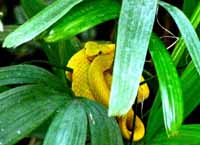3 Steps to Keep You Safe
The green season could also be called the slithering season due to the increase of snake sightings. The rain brings the snakes closer to residences, because of this fact, you should know a few things about them. Out of 139 species of snakes in Costa Rica, only 22 of them are venomous.
Some species spend their time on the ground, camouflaging in foliage or puddles, while others live amongst the trees. Costa Rica is host to two venomous snakes per hector of land. While they may be neighbors, no two venoms are alike. Pit Vipers carry hemotoxin, which affect the blood and muscles. The Ferde-Lance or Terciopelo, as the locals refer to it, is part of the Pit Viper family and is responsible for more deaths than any other snake in Costa Rica.They have the reputation as the most dangerous snake in the country due to their irritability, unpredictable temperament, high population, and location near residences. Terciopelo is responsible for 46% of snake bites, and 30% of hospitalized cases. Even though the Fer-de-Lance is deemed the most dangerous to man, coral snakes carry the most deadly venom, called neurotoxin, which affects the brain. They, however, are not aggressive and usually keep to themselves, choosing landscape far away from homes. As a result, death by coral snake is highly uncommon.
Common sense leads you to believe that if the snake is smaller, it is less of a threat, that it would pack less venom. In this instance, common sense would be very wrong.
Young snakes have not developed the ability to ration their venom. Adult snakes release just enough venom to paralyze the prey that they are hunting. When bit by a young or adolescent snake you are hit with everything that they’ve got!
Numerous species of snakes are referred to as “false” meaning they mimic the look of their venomous brothers but don’t pack the punch to back it up. The false vipers have only two holes on their nose, where as the truly venomous vipers boast four. Instead of full rings painted around their body, false corals only wear 3/4 rings, leaving their belly uncovered. Now, let’s play out this information. If you encounter a snake that resembles a venomous one, don’t move close enough to determine how many nasal passages it has, or roll them over to inspect their rings! A good rule of thumb is to stay at least 3 feet away.
Most snakes strike when they feel threatened or to protect their young. In Costa Rica, there are 600 snake bites a year, but thanks to Clodomiro Picado’s movement, “Law of Protection of Ophidism” the fatality rate has dropped from 7% to almost 0%. Clodomiro is credited as the founder of snake anti-venoms, and moreover successfully campaigned a new law requiring every hospital in Costa Rica carry the anti-venom.
3 steps to avoiding snake bites:
1. Snakes are more active at night, often found in walkways or backyards, therefore it is advised to bring a flashlight with you anytime you need to walk at night.
2. While hiking, be mindful of each step, especially while in areas close to a water source with loose foliage and puddles.
3. While walking on trails, do not touch anything but yourselves. If you need leverage while hiking bring a hiking stick with you. Each tree branch that you are tempted to grab for assistance or move could easily host a venomous snake.
What to do if you are bitten:
In accordance with the American Heart Association
1. Call 9-1-1. It works in Costa Rica just like it does in the States.
2. Remain calm. Your goal is to keep your heart rate as slow as possible, thus buying yourself more time before the venom circulates throughout your body.
3. If possible, immobilize the area that was bitten and keep it below the level of the patient’s heart (the more you move it the faster the venom spreads).
4. If you have a pressure wrap (such as an ACE bandage) wrap the entire bitten limb, but not so tight as to completely cut off circulation. We are not trying to create a tourniquet.
5. Get to the nearest hospital as quickly as possible. If you have a picture or remains of the snake that bit you, bring it. Do not bring a live snake to the hospital! These are the same procedures I used as a paramedic in San Diego. To learn the tips I used to migrate from a San Diego Paramedic to a Costa Rican expat read, Becoming an Expat: Costa Rica.
_______
Resources:
1 Law #13 in 1926
2 Bothrops asper. Integrated Taxonomic Information System. Retrieved 6 November 2006
3 Bolaños R. 1984. Serpientes, venenos, y ofidismo en Centroamérica. Editoria Universidad de Costa Rica, San
José. 136 pp.
Article written by Shannon Enete, author of Becoming an Expat: Costa Rica your guide to your new life in Costa Rica.

